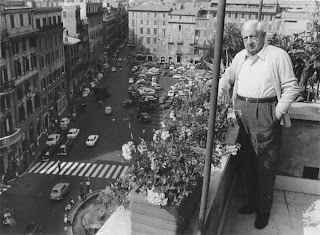 |
| de Chirico on his terrace overlooking Piazza di Spagna |
De Chirico’s home is run as a museum but looks basically as he and his wife left it when he died in 1978, after living there 30 years. The place is so homey it looks completely bourgeois. One of our friends pointed out the worn leather chair parked opposite the TV – looks like he spent a lot of time there!
Visiting the artist’s home, which has his studio and many of his works, as well as inspirations for his work, is a treat. The location is easy – just off the Spanish Steps. But you must make a telephone reservation. Days and hours for tours are limited – usually a couple mornings a week - and the most recent information we have on cost was Euro 5. It’s worth the phone call, in our opinion
 |
| One of de Chirico's metaphysical paintings |
It’s hard to explain de Chirico’s art, except to say that it is unique in many ways and embodies Italian figures from Roman times to the present. And we won’t even try to explain “metaphysical” as it’s used here. Just look at the paintings. You can always consult Wikipedia for more information on the artist, but we like better a blog on de Chirico that was inspired by the blogger’s visit to the home. You can also get some information from the de Chirico Foundation website, although it’s in process of being updated.
De Chirico’s home at Piazza di Spagna, 31, is just around the corner from the Keats-Shelley museum, that is, the bedroom where Keats died. Quite a contrast – in wealth, centuries, and art. Try them both.
Dianne

No comments:
Post a Comment